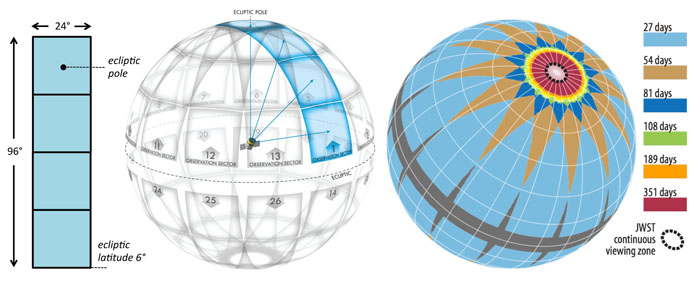Editor’s note: Astrobites is a graduate-student-run organization that digests astrophysical literature for undergraduate students. As part of the partnership between the AAS and astrobites, we occasionally repost astrobites content here at AAS Nova. We hope you enjoy this post from astrobites; the original can be viewed at astrobites.org!
Title: Precision Light Curves from TESS Full-Frame Images: A Difference Imaging Approach
Author: Ryan J. Oelkers and Keivan G. Stassun
First Author’s Institution: Vanderbilt University
Status: Submitted to AJ
Disclaimer by Tarini: The first author of this paper was my supervisor during an REU, and while I was briefly involved with TESS as an undergraduate I did not participate in this work.

Figure 1: Left: field of view of the four TESS cameras. Middle: the twenty-six observation sectors TESS will cover across the northern and southern hemispheres of the sky. Right: the duration for which TESS will observe different parts of the sky, with the James Webb Space Telescope (JWST) continuous viewing zone. [NASA/TESS]
Because TESS is designed to conduct a wide survey, its pixels span a large part of the sky — 21 arcseconds per pixel, to be exact. For comparison, the Wide Field Camera 3 on the Hubble Space Telescope spans 0.04 to 0.13 arcseconds per pixel, depending on the detector. The large arcsecond-per-pixel scale means that the stars in TESS FFIs are more likely to be distorted and blurred into each other, making it difficult to measure changes in brightness (see Figure 2). How can one get around this? The authors of this paper offer up an image-processing pipeline that does the trick.

Figure 2: Comparing the pipeline’s output for three different data sets with different arcsec/pixel scales. The x-axis records magnitude and the y-axis records the deviation from the average magnitude of a given object. The inset images show how stars appear in the typical image from that data set. From left to right, the scales are 6.4”/pix, 15”/pix, 21”/pix (TESS). [Oelkers & Stassun 2018]
Stack, Subtract, Extract
One way to measure how an object’s brightness changes is to count the number of photons it emits over time. This is easy to do when a star is in a sparsely-populated part of an image; it’s safe to assume that any light from that part of the image is coming from the star. In crowded fields, things get complicated. Stars can appear to overlap, making it difficult to tell where the light is coming from.
A way around this is Difference Imaging Analysis (DIA). To do this, you need at least two images of the same part of the sky. Usually, one has a higher signal-to-noise ratio (SNR) than the other. Blur the image with the higher SNR to match the image with the lower SNR, and subtract one from the other. This should eliminate any objects that have a constant brightness and leave behind — you guessed it — the objects that do change brightness!
To determine a DIA approach to TESS FFIs, the authors used NASA’s “End-to-End 6” (ETE-6) simulated FFIs for TESS. To create the higher-SNR image, all 1,348 ETE-6 images were aligned and stacked to create a master frame. Aside from creating a frame to subtract from, stacking several images also ensures that transient objects like asteroids are removed from the master image. To be sure that subtraction had occurred properly, the authors checked the distribution of the values of background pixels in the differenced image. If only variable objects were left behind, then the rest of the pixels ought to be around zero. This is indeed the case with the differenced images that are produced (see Figure 3).

Figure 3: Left: a typical science image, with the colors inverted and an arrow pointing towards a candidate variable object. Middle: the differenced image, with an arrow still pointing at the much more distinct variable object. Right: the distribution of background pixel values from the differenced image. The distribution follows a Gaussian centered at zero, which means that the subtraction occurred properly. [Oelkers & Stassun 2018]
Through the Light Curves, and What the Pipeline Found There
The exact number of variable events (transits and variable stars) injected into the simulated images is unknown, but there should be several hundred of each type. The authors recovered 2,275 stars that showed variability (see Figure 4), which is good news for the pipeline. With their current resources, the authors estimate that they should be able to extract light curves from TESS FFIs a few weeks after data releases. The pipeline is publicly available and can be adapted for other data sets.

Figure 4: Examples of the variable-object light curves extracted from the ETE-6 FFIs. Left: likely simulated periodic variable star. Middle: likely simulated transit or binary candidate. Right: simulated large-amplitude variable star. [Oelkers & Stassun 2018]
About the author, Tarini Konchady:
I’m a first year graduate student at Texas A&M University. Currently I’m looking for variable stars to better calibrate the distance ladder. I’m also looking for somewhere to hide my excess yarn (I’m told I may have a problem).

1 Comment
Pingback: Allgemeines Live-Blog ab dem 16. April 2018 | Skyweek Zwei Punkt Null